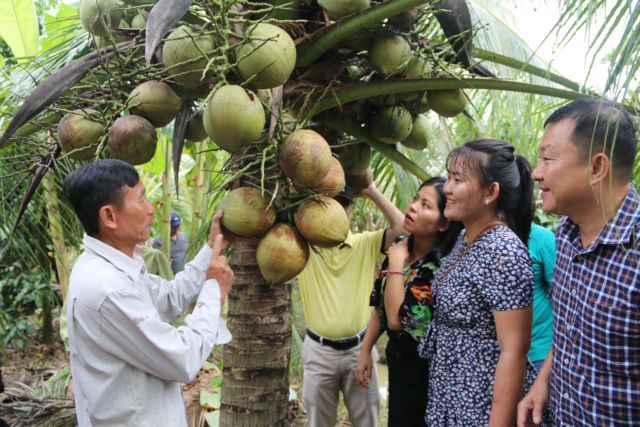 Society
Society

 |
| Cao Văn Lùng (left), owner of a sáp coconut grove in Cầu Kè District’s Hoà Tân Commune in Trà Vinh Province, introduces visitors to sáp coconuts in his grove. – VNA/VNS Photo Thanh Hoà |
TRÀ VINH – The Cửu Long (Mekong) Delta province of Trà Vinh is encouraging farmers to expand the cultivation of specialty sáp coconut.
The province aims to expand the cultivation of the variety by an additional 550ha, taking the total sáp coconut area to about 1,200ha, according to its Department of Agriculture and Rural Development.
Sáp coconut is used mostly for desserts such as coconut shakes, in which coconut is mixed with milk, sugar and ice.
The variety is the province’s well-known specialty and is planted mostly in Cầu Kè District, where the soil is suitable for it.
Lê Trường Sơn, head of the province’s Plant Cultivation and Protection Sub-department, said farmers are encouraged to grow new sáp coconut trees in mixed or old orchards to improve income and meet demand for producing sáp coconut products.
Farmers should grow the nut to Vietnamese or global good agricultural practices (VietGAP or GlobalGAP), or organic standards to have stable buyers, he said.
The department, in co-operation with localities, will assist farmers to link with companies to secure outlets for sáp coconuts, he said.
Thạch Em, who has a 2ha sáp coconut grove in Cầu Kè’s Hoà Tân Commune, said his family grows the trees under VietGAP standards and the trees began to bear fruit after four years.
He uses advanced cultivating techniques such as providing artificial pollination for the trees to increase the number of sáp coconuts in each bunch.
A mature sáp coconut tree can produce 120-150 nuts a year, but only 20-40 per cent of the nuts have the soft and thick pulp that qualify them as sáp (sáp literally means wax), and the remaining have normal pulp.
Sáp coconut trees planted under traditional methods normally yield two to three sáp coconuts in a bunch while those with advanced cultivating techniques can have five to seven sáp coconuts in a bunch, Em said.
Each mature sáp coconut tree provides farmers an income of VNĐ10 million (US$420) a year, he said.
Establishments and companies in the province use sáp coconuts to make products such as jam and candy, according to the sub-department.
The supply of sáp coconuts cannot meet the domestic market demand and the variety is purchased at VNĐ110,000-150,000 ($4.7- 6) a nut, it said.
Nguyễn Thị Cẩm, owner of the Cẩm sáp coconut jam producing establishment in Cầu Kè town, said: “The supply of sáp coconut has never met the demand.”
The supply of the nut is scare during major festivals such as Lunar New Year and the Đoan Ngọ Festival on the fifth day of the fifth lunar month because of high demand, she said.
Her establishment uses 300-400 sáp coconuts a day to make jam to sell to HCM City and other provinces, she said.
Trà Vinh is the country’s second largest coconut producer after its neighbouring province of Bến Tre.
It has 25,000ha of coconut, including more than 4,000ha of coconut planted to organic standards and 722ha of sáp coconut, according to the department.
The province is developing a brand name for sáp coconuts and registering a geographical indication “Dừa sáp Trà Vinh” for the variety. – VNS




